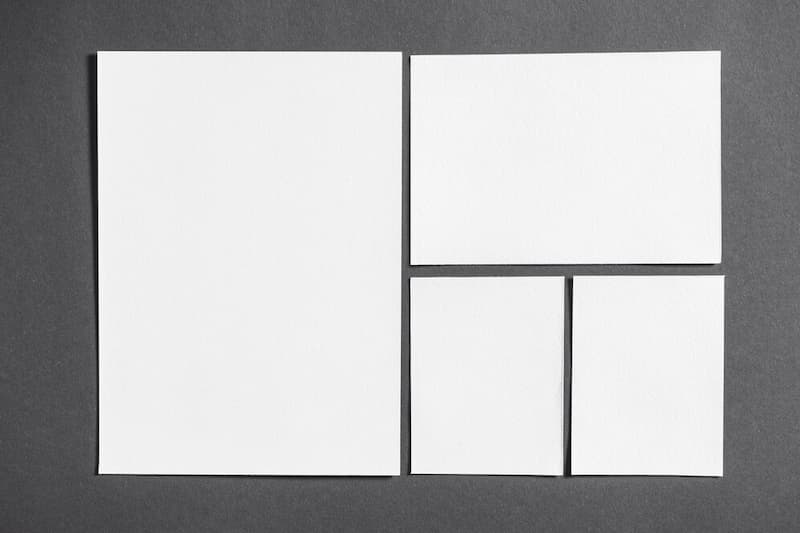
ISO 216 Standard: The Foundation of A4 Paper Size and Its Global Usage
The Role of ISO 216 in Defining A4 Paper Size
ISO 216 is an international standard that defines paper sizes based on a consistent aspect ratio of 1:√2. This allows paper sizes to scale up or down while maintaining the same proportions. A4, one of the A-series sizes, is integral to the system, providing a universally recognized format for printers and print materials. The significance of this standard lies in its consistency—no matter where you are, A4 paper dimensions remain the same, simplifying the printing process for businesses and individuals alike.
A-Series Paper Sizes and Their Relevance
The A-series includes a range of paper sizes from A0 to A10, with A0 being the largest and A10 the smallest. A4 sits in the middle, making it practical for a wide range of tasks. Each size is half the size of the previous one, maintaining the 1:√2 aspect ratio. This makes scaling between paper sizes seamless. Whether you’re printing a document, creating a poster, or designing brochures, the A-series offers the flexibility to adjust the format without altering the content’s proportions. A0 is often used for large posters, A2 and A3 for artwork and presentations, while A5 and A6 are ideal for small leaflets and notepads.
Why A4 Paper is the Global Standard for Printer Paper
A4 paper is recognized as the international standard for paper sizes, used in most countries around the world except for the U.S. and Canada, where Letter size is more common. The global adoption of A4 simplifies communication and printing across borders. Its dimensions make it ideal for a variety of tasks—from simple document printing to creating professional-grade brochures and marketing materials. This uniformity means that documents printed in one country can be easily read and used in another without concern for format differences.
The Benefits of ISO 216 Compliance for Global Businesses
A4 Size: The Universal Standard for International Paper
A4 size paper is the most widely accepted standard for international paper formats. Measuring 210 x 297 mm, this size of paper is recognized across most countries, ensuring that businesses can print and share documents seamlessly, regardless of location. Its universal acceptance eliminates the need for multiple printer paper sizes, making A4 the right size for businesses that work across borders.
Printer Paper Size and Global Compatibility
The A4 paper size is considered the standard for most printer paper sizes worldwide, aligning with ISO 216 guidelines. By using A4 paper, international companies can ensure that their printed materials are compatible with printers and copiers across different countries. This international paper size ensures there are no issues with formatting or resizing when exchanging documents with global partners.
International Paper Sizes vs. Letter-Sized Paper
While letter-sized paper (8.5 x 11 inches) is common in the U.S. and Canada, A4 size paper is the standard for international paper sizes. The dimensions of A4 paper allow for better compatibility across industries globally, reducing the need for formatting adjustments when working with international clients. By adhering to ISO 216, businesses avoid the complexities of managing multiple paper formats like letter-sized paper and A4.
Dimensions of A4 Paper and Larger Formats
A4 paper measures 210 x 297 mm, which makes it ideal for everyday business use. For larger-scale printing needs, companies often turn to A3 or even A0 paper, which measures 841 x 1189 mm. These larger paper size dimensions are perfect for posters, technical drawings, and blueprints. However, for most corporate tasks, A4 size paper remains the most practical choice due to its balance of space and convenience.
A4 Size Paper: The Right Choice for Professional Documents
A4 size paper is not just convenient, but it’s also the right size for maintaining a professional appearance in business communication. Whether printing contracts, reports, or marketing materials, A4 ensures that the documents are clear, organized, and standardized. This eliminates the challenges associated with using various paper sizes, providing a consistent look that reflects a company’s commitment to quality and efficiency.
Comparing A4 Paper with Other Common Paper Sizes
A4 vs. A5: The Difference in Usage
A4 paper measures 210mm x 297mm, while A5 paper is half its size, measuring 148mm x 210mm. While A4 is commonly used for documents, letters, and reports, A5 is better suited for smaller printed materials such as flyers, invitations, booklets, and stationery. A5’s compact size makes it perfect for handheld or portable items, whereas A4’s larger dimensions are ideal for documents that require more space for text and visuals. This makes A5 particularly popular in the hospitality and event planning industries, where small, attractive print materials are key.
A4 vs. A3: When to Use A3 Paper
A3 paper is twice the size of A4, measuring 297mm x 420mm. It is commonly used for printing large diagrams, posters, and visual presentations. While A4 is ideal for everyday office tasks, A3 is often used in creative industries, for instance in graphic design and architecture, where more space is needed to include detailed illustrations or large amounts of information. Both A4 and A3 are critical for any workplace that requires a mix of standard document printing and visual or creative work.
A4 vs. U.S. Letter Size (8.5 x 11 inches)
While A4 is the international standard, U.S. Letter size is the most common format used in North America. Letter paper is slightly wider and shorter than A4, measuring 8.5 x 11 inches (216mm x 279mm). The differences between these two sizes can lead to formatting issues when printing documents intended for one size on paper of another. Most modern printers allow users to select either size, but it’s important to adjust your document settings accordingly to avoid cropping or other issues. Despite these differences, A4 paper offers a more balanced ratio, which can often fit more content on a single page, making it the preferred size outside the U.S. and Canada.
A4 and Larger Sizes: When You Need More Space
For specific tasks, larger paper sizes such as A2, A1, and A0 are necessary. A2, which measures 420mm x 594mm, is commonly used for posters and large prints. A1 and A0, even larger, are often reserved for technical drawings, blueprints, and large-scale advertisements. A4’s versatility makes it suitable for a wide range of projects, but when extra space is needed, these larger sizes offer a solution while still adhering to the consistent scaling of the ISO 216 standard.
Common Uses for A4 Paper in Printing
Everyday Printing Needs
A4 paper is the default choice for most everyday printing tasks such as printing reports, letters, forms, essays, and meeting agendas. Its size strikes the perfect balance between providing enough space for content while remaining compact and easy to handle. Whether you’re printing homework for school, office memos, or legal forms, A4 paper is designed to meet these needs efficiently. Its universal compatibility with printers and copiers ensures that A4 remains the go-to paper size for businesses, educational institutions, and homes.
Brochures, Flyers, and Marketing Materials
A4 paper is frequently used for printing brochures, flyers, and promotional materials. Its dimensions provide plenty of space for images, text, and graphics, making it the ideal format for trifold brochures or folded flyers. Businesses in industries such as real estate, tourism, and retail often rely on A4 for professional-grade marketing materials, as it allows them to present detailed information in a clear and concise manner. A4 is also the preferred size for newsletters and company reports that need to include both text and visuals.
Stationery and Office Use
In offices, A4 paper is essential for day-to-day tasks. It’s the standard size for printing internal memos, client proposals, contracts, and other legal documents. A4 paper is also the typical size for most office stationery, including notepads, letterheads, and envelopes. Since A4 is the global standard, most filing systems, folders, and binders are designed specifically for A4 documents, ensuring that paperwork can be stored and organized easily. This widespread use in professional settings highlights the importance of A4 in maintaining organization and consistency within businesses.
Creative Projects and Artwork
While A3 and larger sizes are often used for artwork, A4 remains a popular choice for creative projects that require smaller prints or sketches. Artists and graphic designers often use A4 for drafts, initial sketches, or smaller scale artworks. It’s also widely used in DIY projects, such as creating personalized stationery, greeting cards, or small-scale posters. A4’s versatility extends beyond professional use, making it a go-to option for personal, creative projects as well.
Practical Guides and Tips for Using A4 Paper
Selecting the Right A4 Paper for Different Printing Needs
When choosing A4 paper, the type of project and printer you are using will determine the best option. The weight of the paper, measured in GSM (grams per square meter), plays a key role in determining its thickness and quality. For everyday office printing, 80 GSM paper is the standard, providing a balance between affordability and quality. For higher-quality print jobs, such as business proposals, presentations, or invitations, 100-120 GSM paper is recommended. Thicker paper ensures sharper images, crisper text, and a more professional appearance.
Best A4 Paper for Inkjet and Laser Printers
Different types of printers require different types of paper for optimal performance. Inkjet printers typically perform better with thicker, coated A4 paper, as the coating helps prevent the ink from bleeding and produces sharper images. On the other hand, laser printers use toner, and smoother paper tends to work better with these printers. Using the appropriate A4 paper for your printer will not only improve the quality of your prints but also help prolong the lifespan of your printer by reducing the risk of jams or paper feed issues.
Reducing Paper Waste in Offices and Homes
Reducing paper waste is not only environmentally friendly but also cost-effective. To minimize waste, consider printing double-sided documents and using the print preview option to avoid errors that lead to unnecessary reprints. Opt for digital alternatives when possible, such as sharing documents via email or cloud-based systems. Additionally, recycling unused A4 paper or purchasing recycled paper can significantly reduce your environmental footprint.
Ensuring Your Printer is Set to the Correct Paper Size
One common issue that arises during printing is misalignment caused by incorrect paper size settings. Most printers are set to either A4 or Letter size as the default, depending on the region. To avoid misprints or cropped documents, always ensure your printer is set to A4 if you are using this size. Adjusting the default settings is easy and will save time and resources by preventing errors. Modern printers often include easy-to-access settings that allow you to switch between A4 and other paper sizes effortlessly.
FAQs Section Based on “People Also Ask”
What is the standard size of A4 paper?
A4 paper measures 210mm x 297mm (8.27 x 11.69 inches) and is defined by the ISO 216 standard. This paper size is commonly used for printing documents, reports, and brochures across the globe. As part of the ISO 216 standard, A4 is the most popular paper size used for specific purposes in offices and homes worldwide. Its dimensions are often expressed in inches, making it easy to understand and adopt in international contexts.
How does A4 paper differ from Letter size paper?
A4 paper is slightly longer and narrower than U.S. Letter size paper, which measures 8.5 x 11 inches. While A4 is the standard size in most countries, Letter size is more commonly used in the U.S. and Canada. Additionally, the dimensions of A4 paper allow for a better aspect ratio, which is why A4 size is commonly used for international documents, while Letter size is more specific to North American printing tasks. Although both sizes are used for general printing, it’s important to note that many modern printers can handle both formats.
Can I use A4 paper in the U.S. where Letter size is common?
Yes, most modern printers in the U.S. can handle both A4 and Letter sizes. However, it’s crucial to adjust your printer settings to match the paper size being used to avoid cropping or misalignment. For businesses or individuals frequently working with international documents, A4 is often the right choice due to its compatibility across borders. While Letter size is popular in North America, using A4 paper ensures a more standardized approach for those working with global clients.
Is A4 paper suitable for all types of printers?
A4 paper is compatible with most inkjet and laser printers. However, it’s essential to choose the right type of A4 paper based on your printer. For example, thicker or coated A4 paper works better with inkjet printers, while smoother, thinner paper is more suitable for laser printers. This allows for high-quality printing while avoiding paper jams or other issues. Laser and inkjet printers generally perform well with A4, making it a reliable choice for various printing tasks, including high-quality paper outputs.
What is the difference between A4 and A3 paper?
A3 paper is double the size of A4, measuring 297mm x 420mm, making it ideal for larger documents such as posters or architectural plans. While A4 is the standard for everyday printing tasks, A3 size paper is commonly used for specific purposes that require more space. A-class paper sizes, like A4 and A3, are often expressed in millimeters to maintain accuracy. The paper industry uses A3 for larger formats, while A4 remains the most popular paper size for documents. Larger formats such as A0, A1, and A2 paper may be used for even bigger projects, but A4 and A3 sizes are the most frequently used for practical office work.
A4 paper is the global standard for printing tasks, offering the versatility and consistency needed for both personal and professional use. Its dimensions, defined by the ISO 216 standard, ensure compatibility with most printers and provide a reliable format for various printing needs, from everyday documents to marketing materials. By understanding the nuances of A4 paper, its comparison to other sizes, and practical tips for its usage, you can make informed decisions that enhance your printing efficiency and quality across different contexts.



